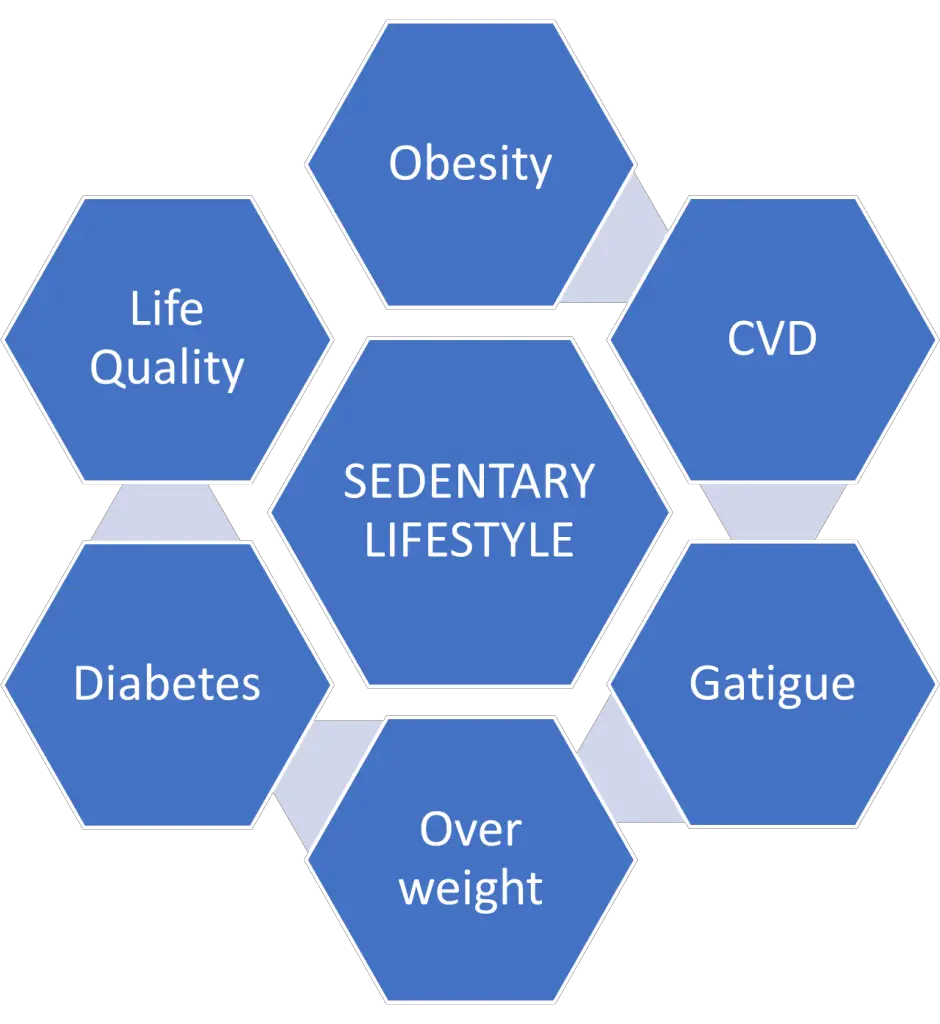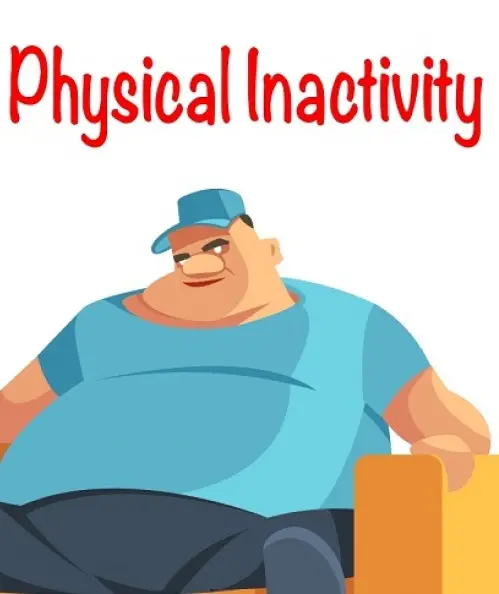
Excerpts
Studies have shown that individuals with sedentary lifestyles tend to experience high levels of stress and anxiety. The good news is that adopting an active lifestyle by engaging in regular physical activity, taking breaks from sitting, and stretching throughout the day can help counteract the harmful effects of sedentary habits.
Topics Discussed
General
What is meant by a sedentary lifestyle?
Symptoms of Sedentary Habits
What has prompted this sedentary behaviour?
Some of the Reasons Why Inactivity Has Increased Sedentary Lifestyle.
Sedentary Lifestyle Impact Checkup
General
A sedentary (characterized by much sitting and little physical exercise.) lifestyle is a way of living that involves very little physical activity. This often means spending prolonged periods sitting or lying down, with minimal movement and little engagement in physical exercise or activity.
People who adopt sedentary lifestyles might spend most of their time sitting at desks, watching television or playing video games, rather than being active.
This kind of lifestyle is known to be linked to a wide range of health concerns, including.
- Overweight,
- Obesity
- Heart problems,
- High blood pressure,
- Metabolic disorders.
- Other negative outcomes
To avoid these negative outcomes, it’s essential to participate in regular physical activity. Exercise doesn’t only promote physical health, but it also aids in stress management, promotes mental wellness, and assists with weight management. To summarise, living a sedentary lifestyle can have significant implications for one’s wellbeing, so adopting a more active lifestyle is essential for overall health and wellbeing.
What is meant by a sedentary lifestyle?

In today’s fast-paced world, we have become accustomed to spending a considerable amount of time sitting or lying down, leading to a sedentary lifestyle. Advances in technology and automation have made our lives more convenient, but at the same time, they have led to increased physical inactivity. Most people spend a significant portion of their day in a seated position, whether it’s in front of a computer screen, television or while commuting. Unfortunately, sitting for prolonged periods has a severe effect on our physical fitness and health, and can lead to various health conditions like obesity, heart disease, and type 2 diabetes. That’s why it’s crucial to incorporate physical activity and exercise into our daily routine. Engaging in these activities regularly has numerous benefits such as maintaining a healthy weight, strengthening muscles and bones, and reducing chronic disease risk. Therefore, adopting a healthy balance between sedentary behavior and physical activity is a must for a healthier lifestyle.
Symptoms of Sedentary Habits

Sedentary lifestyles are becoming more common in our present-day society. These habits are characterized by minimal physical activity, which can lead to various health problems.
- Muscle Imbalances
For instance, sitting for prolonged periods can result in muscle imbalances, which may cause chronic pain and conditions such as carpal tunnel syndrome –( Animation courtesy of Visual Health Solutions, LLC can be seen in this video)
- Individuals with sedentary lifestyles have an increased risk of developing negative impacts.
- Obesity,
- High blood pressure,
- Low back pain,
- Poor posture.
- Increase the chances of developing diabetes,
- Heart disease, and
- Certain types of cancer.
The negative impacts of sedentary habits are not only limited to physical health but also have significant implications on mental well-being. Studies have shown that individuals with sedentary lifestyles tend to experience high levels of stress and anxiety.
The good news is that adopting an active lifestyle by engaging in regular physical activity, taking breaks from sitting, and stretching throughout the day can help counteract the harmful effects of sedentary habits.

- Tiredness
If you are always tired, it could be that you’re gaining weight. Excess fat can cause inflammation in your body, which can lead to a perpetual state of fatigue and tiredness.
Tired people tend to have some amount of energy but are impatient and experience muscle weakness which is tackled by rest.
- Fatigue
People who are fatigued have low stamina, difficulty sleeping and are sensitive to light. To reduce fatigue, eat balanced meals that are rich in fibre-rich carbs, lean protein, and healthy fats. There are several ways to identify whether you have an imbalance in your diet. One way is to think about how many times you feel hungry during the day; if it’s more than once per hour or two, you might have an issue with eating too often due to blood sugar spikes – a sharp increase in the magnitude or concentration of something.

(Blood sugar spikes occur when sugar, builds up in the bloodstream. For people with diabetes, this happens because of the body’s inability to properly use glucose)
In addition, if the foods you indulge in are simple sugars or lacking in nutrients, this will also lead to a rapid decrease in blood sugar levels, causing you to feel hungrier shortly after eating than if your diet was more balanced.
It’s important to keep your blood sugar levels in your target range as much as possible to help prevent or delay long-term, serious health problems, such as heart disease, vision loss, and kidney disease. Staying in your target range can also help improve your energy and mood.
2. Breathlessness
Breathlessness can sometimes be a frightening and unsettling experience. It is the feeling of not being able to catch one’s breath, often accompanied by rapid or shallow breathing. Breathlessness can be caused by a variety of factors such as physical exertion, anxiety, asthma, allergies, heart or lung conditions, and high altitude. It is important to identify the cause of breathlessness in order to receive appropriate treatment or management. If you experience frequent or severe breathlessness, it is advised to consult a medical professional. Taking slow, deep breaths, staying hydrated, avoiding triggers such as smoke or pollution, and engaging in regular exercise can help to prevent breathlessness.
Working with overweight body may create breathlessness.
- Snoring
People who snore tend to sleep poorly, making it more likely they will gain additional weight. They’ll experience food cravings, have a slower metabolism and their hormones, ghrelin and leptin, will be out of balance making them feel both hungrier and less full. Snoring can be corrected by surgery.
If you already practice a healthy lifestyle yet still gain weight and experience shortness of breath, see your doctor immediately.
- Food Craving
If you crave sweets and have a significantly increased appetite, weight gain may be the cause.
If you’re having problems reducing weight with other approaches like exercise or dieting, you might want to consider gastric sleeve surgery. Patients are unable to consume as much because of the limited stomach capacity.
Stress and depression can lead to weight gain by causing the adrenal glands to release the hormone cortisol, which in turn increases appetite. Speak to a registered nutritionist and come up with a food plan that curbs cravings and manage your diet
- Hypertension is a weight symptom
Being overweight or obese increases your risk of developing high blood pressure.
In fact, your blood pressure is more likely to be elevated the more weight you have. Additionally, shedding kilograms will lowerthe blood pressure.
- Visibly Gained Weight
Weight gain is an incredibly common symptom that is typically associated with obesity. This can occur due to a variety of factors, such as poor diet, sedentary lifestyle, hormonal imbalances, genetics, and medications. As a result of this people gain, weight.
What has prompted this sedentary behaviour?
Nowadays, it is quite common to find people living a sedentary lifestyle due to various reasons that have led to the increase in this behaviours. One of the primary reasons is the significant impact of technology on our daily lives. The widespread use of gadgets like smartphones, computers, and televisions encourages individuals to spend more hours sitting and indulging in sedentary activities. Besides, many jobs now call for sitting at a desk or computer for prolonged periods, which can contribute to an overall lack of physical activity. Similarly, the rise of automation and convenience factors has further made physical exertion less necessary, resulting in a sedentary lifestyle for many individuals. Additionally, changes in the food industry have led to the consumption of highly processed, calorie-rich foods, which contribute further to this behavior. Ultimately, these factors and many others have caused a decline in physical activity and made sedentary lifestyles the modern norm. However, this lifestyle poses negative health consequences that individuals must be aware of to lead healthier lives.
Some of the Reasons Why Inactivity Has
Increased Sedentary Lifestyle.

Inactivity has increased over the years due to various reasons including advancements in technology, changes in work environments, lack of physical education, and an increase in sedentary leisure activities. Many people spend the majority of their day sitting down, whether it be at a desk job, watching TV, or playing video games. This can lead to serious health problems such as obesity, heart disease, and diabetes. Additionally, the rise of the internet and social media has resulted in more sedentary leisure activities, making it easier for people to spend their free time sitting down instead of engaging in physical activity. The lack of physical education in schools and the reduction of funding for recreational programs in some communities are also contributing factors. To combat the negative effects of a sedentary lifestyle, it is important for individuals to make a conscious effort to be more active throughout the day, whether it be through exercise, taking regular breaks to stand and move around, or incorporating more physical activity into leisure activities.
- Rise in desk jobs coupled with emerging technologies in the last few decades, such as laptops and desktops
- An increasing amount of time spent on the phone and social media
- Hours spent sitting during commute time to work
- Long work hours (being a workaholic)
- Rise in-home delivery cultures has cut down on people’s need to visit stores physically
Now that we have significantly discussed what a sedentary lifestyle means let us illustrate the effects of physical inactivity on health.
Sedentary Lifestyle Impact Checkup
A sedentary lifestyle can have a negative impact on one’s physical and mental health. Here is a checklist to help determine if you may need to make changes to your lifestyle:
1. Do you spend more than 8 hours sitting every day?
2. Do you have a job that requires you to sit for most of the day?
3. Do you watch TV or use electronic devices for more than 2 hours a day?
4. Do you avoid physical activities and exercise regularly?
5. Do you experience muscle stiffness or pain?
6. Do you feel tired and have trouble concentrating?
7. Do you have trouble sleeping or feel depressed?
If you answered yes to most of these questions, it is advisable to incorporate physical activity and movement into your daily routine. Consider taking short breaks to stretch or walk around, finding a workout routine that suits you, and limiting the use of electronic devices. A sedentary lifestyle can have serious consequences, but with small changes, you can improve your overall health and well-being.
A Sedentary Lifestyle Health Checkup is recommended to help assess the damage to your body caused by a lack of physical activity. This package examines your
Liver Function,
Kidney Function,
Lipid Profile,
HbA1c,
CBC,
Cardiac Risk Markers,
Vitamin D,
And other factors to provide a clear overview of your health.
Sedentary Lifestyle Impact Checkup –
Advanced
A sedentary lifestyle is a way of life that involves little or no physical activity. While it may seem like an easy way to avoid exhaustion, it can cause serious health problems over time. An advanced sedentary lifestyle checkup includes a comprehensive evaluation of your physical health by a medical professional. This checkup provides an in-depth analysis of your body composition, oxygen uptake and blood pressure, as well as, tests for chronic diseases such as diabetes or heart disease. The checkup helps identify physical weaknesses that can lead to complications in the future. Your physician will recommend lifestyle changes, including diet and exercise plans, to correct shortcomings, all while providing an optimal chance of improving your overall health. It is essential to maintain adequate levels physical activity and reduce the amount of time you spend sitting. If you live a sedentary life, an advanced sedentary lifestyle checkup is key to maintaining good health, vitality and longevity.
Millets as Food Supplement

……Millets, also known as ancient grains, have been widely recognized for their numerous health benefits. One of the most notable benefits of millets is their assistance in weight management. Apart from being excellent sources of protein, fiber, and other essential nutrients, millets can be incorporated into your diet in a myriad of ways to help you achieve your weight loss goals.
A common approach to leveraging the weight management benefits of millets is by substituting them for other refined grains in your diet. This can be achieved by simply swapping regular rice or wheat with millet-based dishes like millet porridge or bread made from millet flour. Millets are also versatile and can be added to salads, soups, stews, and even as a base for vegetarian patties or burgers.
It’s crucial to seek advice from your doctor or a nutritionist before making any significant modifications to your diet. With millets as a friendly assistant, you can achieve your weight loss goals sustainably and enjoyably.……

